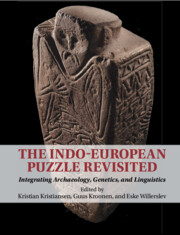Book contents
- The Indo-European Puzzle Revisited
- The Indo-European Puzzle Revisited
- Copyright page
- Contents
- Figures
- Tables
- Contributors
- Preface
- Introduction
- Part I Early Indo-European and the Origin of Pastoralism
- Part II Migratory Processes and Linguistic Dispersals between Yamnaya and the Corded Ware
- Part III The Cultural and Linguistic Significance of Bell Beakers along the Atlantic Fringe
- 9 From the Steppe to Ireland: The Impact of aDNA Research
- 10 Beaker Culture Metal and Mobility in Atlantic Europe: Some Implications for Genetic and Language Origins
- 11 “From the Ends of the Earth”: A Cross-Disciplinary Approach to Long-Distance Contact in Bronze Age Atlantic Europe
- 12 With the Back to the Ocean: The Celtic Maritime Vocabulary
- 13 European Prehistory between Celtic and Germanic: The Celto-Germanic Isoglosses Revisited
- Part IV The Bronze Age Chariot and Wool Horizons
- Part V Kinship Systems, Marriage, Fosterage, Free, and Unfree
- Concluding Reflections
- Index
- References
9 - From the Steppe to Ireland: The Impact of aDNA Research
from Part III - The Cultural and Linguistic Significance of Bell Beakers along the Atlantic Fringe
Published online by Cambridge University Press: 29 April 2023
- The Indo-European Puzzle Revisited
- The Indo-European Puzzle Revisited
- Copyright page
- Contents
- Figures
- Tables
- Contributors
- Preface
- Introduction
- Part I Early Indo-European and the Origin of Pastoralism
- Part II Migratory Processes and Linguistic Dispersals between Yamnaya and the Corded Ware
- Part III The Cultural and Linguistic Significance of Bell Beakers along the Atlantic Fringe
- 9 From the Steppe to Ireland: The Impact of aDNA Research
- 10 Beaker Culture Metal and Mobility in Atlantic Europe: Some Implications for Genetic and Language Origins
- 11 “From the Ends of the Earth”: A Cross-Disciplinary Approach to Long-Distance Contact in Bronze Age Atlantic Europe
- 12 With the Back to the Ocean: The Celtic Maritime Vocabulary
- 13 European Prehistory between Celtic and Germanic: The Celto-Germanic Isoglosses Revisited
- Part IV The Bronze Age Chariot and Wool Horizons
- Part V Kinship Systems, Marriage, Fosterage, Free, and Unfree
- Concluding Reflections
- Index
- References
Summary
In 2015, the genetics laboratories of Harvard, Jena, and Copenhagen (Allentoft et al. 2015; Haak et al. 2015) published aDNA evidence for the extensive human migration that appeared to spread from the steppelands north of the Black and Caspian Seas, both eastward, as far as the Yenisei River and, ultimately, as far west as Britain (Olalde et al. 2018) and Ireland (Cassidy et al. 2016). The source of the expansion was credited to a population whose genomic signature emerged in the steppelands and was primarily comprised of an admixture of both a local Eastern Hunter Gatherer (EHG) origin and a more distant Caucasian Hunter Gatherer (CHG) origin, associated with populations from the area between the Caucasus and the Zagros region. This combination (EHG + CHG) typified the Yamnaya culture, an Eneolithic cultural horizon whose home territory extended from the Urals to the Danube and whose archaeological remains had been known to have spread westward, at least as far as Hungary (Ecsedy 1979). The genetic signature of the Yamnaya (or another culture with a similar genetic composition) was found among about 75% of the Corded Ware burials sampled in Germany, whose previous populations were exclusively represented by local Western Hunter Gatherer (WHG) and Anatolian Farmer (AF) genes. Samples of mtDNA recovered from both Yamnaya and Corded Ware burials also suggested an east-west cline of steppe ancestry, with its highest representation in eastern Corded Ware burials in Poland and the Czech Republic, while western Corded Ware females appeared to derive from local populations (Juras et al. 2018).
- Type
- Chapter
- Information
- The Indo-European Puzzle RevisitedIntegrating Archaeology, Genetics, and Linguistics, pp. 129 - 145Publisher: Cambridge University PressPrint publication year: 2023



